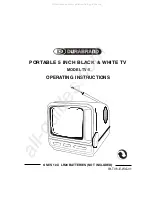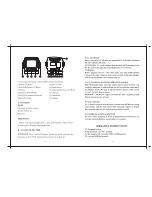
13
REV 41332-20120120
ENGLISH
41332
Connecting Electrical Loads
1 . Let the engine stabilize and warm up for a few
minutes after starting
2 . Plug in and turn on the desired 120/240 Volt AC
single phase, 60 Hz electrical loads .
– DO NOT connect 3-phase loads to the generator .
– DO NOT connect 50 Hz loads to the generator .
– DO NOT overload the generator .
Stopping the Engine
1 . Turn off all electrical loads connected to the
generator . Never start or stop the generator with
electrical devices plugged in and turned on .
2 . Press and release the STOP button on the Remote
Control device OR turn the Ignition Switch to the
“OFF” position .
3 . Turn the Fuel Valve to the “OFF” position .
Important: If the generator will be moved or stored turn
the Fuel Valve to the “OFF” position, press the Ignition
Switch and the Battery Switch on the power panel to the
“OFF” position .
Connecting a generator to your electric utility
company’s power lines or to another power source
may be against the law . In addition this action,
if done incorrectly, could damage your generator
and appliances and could cause serious injury or
even death to you or a utility worker who may be
working on nearby power lines . If you plan to run a
portable electric generator during an outage, please
notify your electric utility company immediately
and remember to plug your appliances directly
into the generator . Do not plug the generator into
any electric outlet in your home . Doing so could
create a connection to the utility company power
lines . You are responsible for ensuring that your
generator’s electricity does not feed back into the
electric utility power lines .
If the generator will be connected to a building
electrical system, consult your local utility company
or a qualified electrician . Connections must isolate
generator power from utility power and must comply
with all applicable laws and codes .
NOTE
OPERATION
do Not Overload Generator
Capacity
Follow these simple steps to calculate the running and
starting watts necessary for your purposes .
1 . Select the electrical devices you plan on running at
the same time .
2 . Total the running watts of these items . This is
the amount of power you need to keep your items
running .
3 . Identify the highest starting wattage of all devices
identified in step 1 . Add this number to the number
calculated in step 2 . Surge wattage is the extra
burst of power needed to start some electric driven
equipment . Following the steps listed under “Power
Management” will guarantee that only one device will
be starting at a time .
Power Management
Use the following formula to convert voltage and
amperage to watts:
Volts x Amps = Watts
To prolong the life of your generator and attached
devices, follow these steps to add electrical load:
1 . Start the generator with no electrical load attached
2 . Allow the engine to run for several minutes to stabilize .
3 . Plug in and turn on the first item . It is best to attach
the item with the largest load first .
4 . Allow the engine to stabilize .
5 . Plug in and turn on the next item .
6 . Allow the engine to stabilize .
7 . Repeat steps 5-6 for each additional item .
Never exceed the specified capacity when adding
loads to the generator .
NOTE
















































